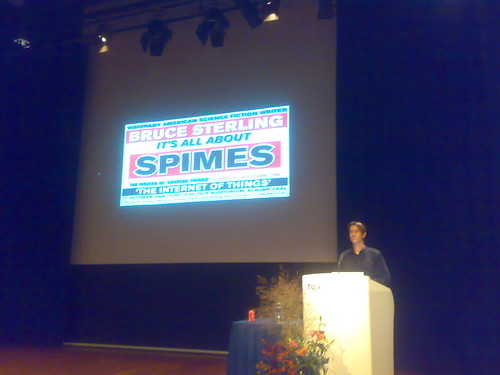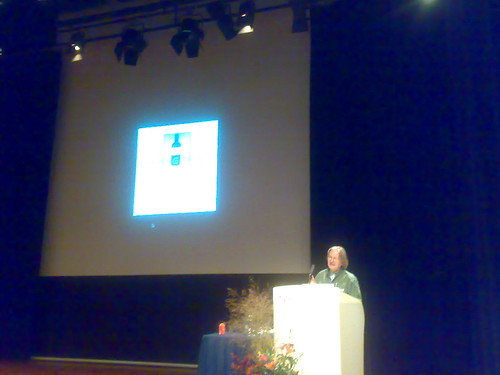Lecture on Spimes at the TU/e
Bruce Sterling lectured at the Technical University of Eindhoven this afternoon about the status of and internet of things.
The introduction is given by Koert van Mensvoort.

Koert starts by wondering what it means to live in an information age, where DNA and the human genome are mapped, bits and atoms are linked and information has more value than physical objects.
In a world of “arphids” (Sterling) and “everyware” (Greenfield), who already has an RFID-chip implanted? (it is said that even our queen is already tagged!).
Companies are involved in creating new ip- standards. It is of now possible to provide every sand-grain with a network address. Our world used to consist of objects, now in becomes information. An expert in this field in Bruce Sterling, who is going to elaborate on Spimes in an Internet-of- things.
Bruce Sterling

Starts by throwing some terms at us. like Internet of things and Spimes. Also, he mentions his famous book Shaping things which is a “rare piece of science fiction”.
What is a spime? Spimes are about ubiquity and sustainability, where the spime could be a path for a sustainable way of producing and consuming (although we will use different terms for that in the near future). Due to tracking and tracing of all materials used, but moreover, due to the traceability of the process, we can achieve sustainability. It concerns making mistakes in the process but also archiving them in order to respond and learn way faster than we now do.
Sterling now shows an early sketch; a spime-meme-map. which starts with “space-time -stuff”. In space-time we have things. We have to invent them – they don’t just appear. Probably these things are designed on the Internet. All their info is online and they all have unique identities they will be fabricated (DIY) rather than manufactured. They are traceable in space and time, we can “Google” everything. All things will be easier to recycle, due to all the metadata available. When the product is no longer needed, and thus its physical form recycled, a real of meta-data will linger on the Web as remainder. All “things” are roaming in a pool of bits, atoms and environment. Bits that say stuff about atoms that say something about the environment, and so on…
Sterling continues by stating that there are no real Spimes yet. What is there is an ideal; a concept to what we might use/ can event. You might say that Spimes are an industrial design-approach for an internet of things. Sterling shows his t-shirt, which is from the Near-future-lab, where Nicholas Nova tried to create a Spime according to the ‘rules’ set by Sterling:
It has to be designed on the internet, it has to have a unique code and it is fabricated. Also, it has to be recyclable.
Spimes are products that are mostly data, and sometimes physical. Sterling mentions some Spime-theory objects and phrases, in order to give a notion of the kind of disciplines involved in a internet of things; thinglinks, participatory panopticon, augmented reality, blogjects, – geo-spatial web, semantic web, user-centered design- all thoughts that roam around – different field of practice that are convergent.
Moreover there is a little cluster of industrial developers and startups that are moving conceptual ideas to a real business. They are trying to really ‘materialize’ this notion of an Internet of things, developing not only products, but also a new vocabulary in a way. Sterling want to share those thoughts and new vocabulary- things by sating things said at the “internet-of-things” special event at the PICNIC 2008 in Amsterdam last month:
” the internet of things is lonely; it needs more things”
“Google and Cisco are in the loop – now”
“Information processing are producing behavior”
“Smart-self-disclosing objects”
“Behavior brings meaning to spaces that have no meaning”
“It is about connecting real things, not key-rings with key-rings”
“No push-pull product”
“Things are not televisions”
“If your house is running on vista, you have a problem”
“It is your toy, and it leads to your page”
All the quotes can be read on Sterling’s blog, which is here ( i could not blog them all, it was too much):
The book “shaping things” is written in a pop-science way, introducing an internet of thing vocabulary. Concepts like the smart house is effectively dead, where the failed vocabulary of A.I. is shifted towards the vocabulary of the social web. This will also happen with an internet of things; when it is there, we will not call it that, we’ll have different names and different vocabularies for it.
Now, there is a “coopetative” situation of the start of intent of things companies – the first step is via simple rfid-readers and simple chips. Sterling shows the Tikitag, which is a nifty peel-off stickertag that comes with an easy usb- RFID reader (it is actually a Philips spin-off). This shows involvelemnt of industry in a former purely conceptual space. Ip protocols for things are being made by Cisco; Nokia is also in there with near-filed communication and the Nokia rfid phone. Where the iPhone is a sort of remote control for reality, Nokia is higher in design philosophy by really wanting to crate amazing stuff.
The term Spime is a placeholder – the word internet will demise – it is a design direction. These are a part of that few ideas that are as alien for our experience as internet for people from the 50-ties. It is in the same ballpark. It is maybe not weird enough to be true, but it is weird enough.
Sterling states that he is not a designer. He does not like design objects, he is not a fan. He is a design theory fan, though. “I am looking for an intense departure from the way we use our products. My life is changed since meeting up with design theorists”
Sterling summarizes three principles for interaction between human and thing:
– is it beautiful? In such a way that I want to show it to other people? Or in a display case?
– is it meaningful? Does it have an emotional value? Does it have meaning or a long time?
– does the thing work? Is it useful? Is it a broken thing that I do not want to throw?
“I am expanding my social network by giving things away. I do not miss them. I have things that are really good. I think about my basic relationship with my material surrounding. They (things) are costing me time and space, stealing your life and stealing your space. If you look at your things from that perspective, you get into a new universe, and it is liberating…”
q&a:
Q: Do you still have an emotional-value with products in a Spime world?
A: Yes but different. Emotional attachment in a museum-kind of way. The most attachment can be found in anxiety; we do not want to lose or damage our things.
Q: A new sense of privacy on this subject?
A: yes, definitely. Katherine Allbright, for instance, is one who writes about the demonic sides of technologies like rfid. This technology has a large misuse-potential. The word privacy is not even near enough – this is beyond Orwellian. Using the word privacy is the same as using the word ‘automation’ now. It is useless. We have to come up with a new type of discourse for this subject.
First- we do not have brakes, secondly, we do not have any words to describe these brakes we need in surveillance-activities that are ven taking place today (google, cctv, and so on…)
Q: How do we keep our creativity? We need junk to be creative.
A: Creativity is not in mass production. It is a Duchampian kind of argument that you can be creative by combining pieces of junk. Stimulate your mind via learning new technologies, not looking in your atttic to junk.
One example is EPC global, who wants to put rfid-codes on everything. How many things have got tagged in your house? Probably none. While you do have an uncountable number of barcodes in your house. There is no method of interacting with a lot of stuff in your house, yet.There a lots of opportunities there.
Q: What about black-spots in this internet of thing?
A: There are intentional and accidental black-spots. Like Kevin Kelly once argued, you need holes in the network. Networks that are truly ubiquitous are worthless.